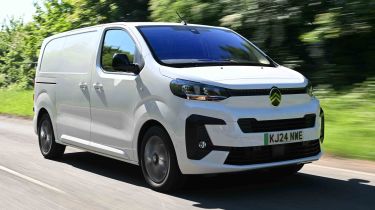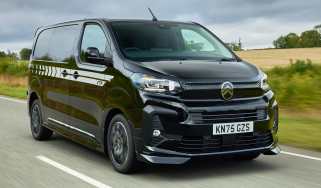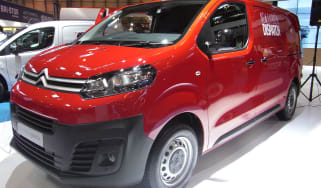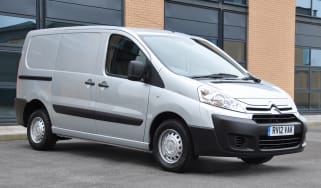Citroen Dispatch van review
The medium-sized Citroen Dispatch mixes car tech with van versatility in a compact package
Our opinion on the Citroen Dispatch
While the Citroen Dispatch name has been around since 1994, the current third generation was launched in 2016. It was given a facelift at the end of 2024, but the van’s overall appeal in the medium-sized van sector remains unchanged. It’s not the most spacious van in the class, but it’s quite comfortable to drive, has plenty of car-derived equipment on board and is available with either diesel or all-electric powertrains. There are two body lengths on offer, while a crew van variant offers a level of versatility that will be useful for certain businesses. Overall, it’s a decent medium-sized van with no vices and plenty of useful touches.
About the Citroen Dispatch
The third-generation Citroen Dispatch is a medium-sized van that goes by many different names as a result of mass badge engineering. For starters, it’s called the Citroen Jumpy in Europe, and when it was first launched in 2016 it arrived alongside the Peugeot Expert. Later the Vauxhall Vivaro (and Opel version) joined the fray when PSA Group took over the company, then when PSA merged with Fiat Chrysler Automobiles in 2021, the Fiat Scudo joined the fleet. As well as these vans, the Toyota Proace is also derived from the same model. But that’s not all, because there are passenger carrying versions of all of the above, so you also have the Citroen SpaceTourer, Peugeot Traveller, Vauxhall Vivaro Life, Opel Zafira Life (not sold in the UK), Toyota Proace Verso and Fiat Ulysse (also not sold in the UK), plus there’s the Citroen Holidays campervan, too.
Used - available now

2022 Abarth
595
26,293 milesManualPetrol1.4L
Cash £15,700
2021 Jaguar
XE
45,309 milesAutomaticPetrol2.0L
Cash £21,300
2022 Nissan
Qashqai
11,077 milesAutomaticPetrol1.3L
Cash £18,499
2023 Tesla
Model Y
64,942 milesAutomaticElectric
Cash £21,500Confused? You don’t need to be, because all of these vans share common characteristics; it’s just minor design tweaks to the nose and interiors that differentiate them. For the update in 2024, the Citroen Dispatch gained the company’s latest corporate look with a new oval badge and a smoother grille, while inside the cabin was updated with a new infotainment touchscreen and digital driver’s display.
Under the skin, the Dispatch shares platform tech with PSA Group cars such as the Peugeot 308, so it’s fitted with some advanced safety features such as automatic emergency braking, lane assist and speed limit assist. The Dispatch is available in two body lengths called M and XL (there was a compact option before the facelift, but this is no longer offered), plus there’s a six-seat Crew Van variant offered in both body lengths. Two diesel engines and an all-electric powertrain are available, while all versions are front-wheel drive, and the more powerful diesel is available with an automatic gearbox.
Prices start from around £28,000 for the Dispatch diesel, while the electric e-Dispatch is a little higher at roughly £41,000 before any discounts are included – you can thank the large 75kWh battery for the price hike. The more powerful diesel is around £1,300 more than the standard version (for a jump from 118bhp to 142bhp) while it’s another £1,500 on top of that to add an eight-speed automatic gearbox.
While front-wheel drive is standard across the line-up, Citroen does offer the Worksite Pack for mild off-road use. This raises the ride height by 175mm, adds a skid plate to protect the engine and a full-size spare wheel, although there are no cross-climate tyres in the package, and the van’s traction control system doesn’t have off-road driving modes.
Fitting a 75kWh battery to the electric e-Dispatch gives it a range of up to 230 miles according to the official figures, while a maximum charging rate of 100kW means a DC charge takes the battery from 5-80 per cent capacity in 45 minutes. Not the fastest charging rate around, but enough to add a decent amount of range in a lunch break.
All of Citroen’s vans come in Enterprise or Driver trims, with a price difference of around £2,700 between them. It’s worth noting that not all engines are available in both specs, with the automatic model only offered in Enterprise trim, while the Crew Van only comes in Enterprise trim with the more powerful manual diesel or as an EV. All trims and engines are available in both M and XL body styles, while the Crew Van is XL only because it needs the extra length for rear legroom, and is also only offered in more basic Enterprise spec.
Standard kit is decent, with all models featuring twin sliding side doors, a three-seat layout, air-conditioning, a 10-inch driver’s display and 10-inch touchscreen with wireless phone connectivity, electric windows, Bluetooth, rear parking sensors, cruise control, auto lights and wipers, remote central locking and a multifunction steering wheel.
Driver specification costs around £2,700 extra and adds Citroen’s Moduwork through-loading bulkhead for longer items, plus sat-nav, LED headlights, front and rear parking sensors and a reversing camera, a digital mirror and blind-spot warning, among other add-ons.
MPG and running costs
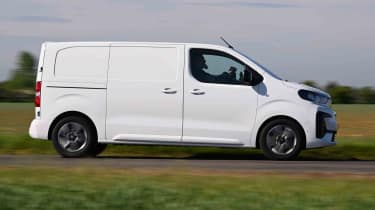
| Pros | Cons |
|
|
The diesel version of the Citroen Dispatch kicks off from £28,000, while the electric e-Dispatch starts at £41,200 before any grants or discounts are included. The Crew Van starts at £32,000 in diesel form, with the electric version coming in at £46,500 before any grants. Those prices are for the standard M body length, while upgrading to the XL version of either powertrain is a reasonable £800 extra for the van, and a bargain £200 for the Crew version.
For the 2024 update, Citroen simplified the model line-up, so only Enterprise and Driver trims are offered. This did increase prices, because there is no longer a basic variant offered, but then it’s arguable that the Enterprise model has all the kit you could need. There are 10-inch driver and touchscreen displays, twin sliding doors, a full steel bulkhead and plenty of convenience items, such as air-conditioning, auto lights and wipers, rear parking sensors, heated and electrically adjustable mirrors, a three-seat layout, auto main beam, lane assist and speed limit assist, wireless phone connectivity and one-touch electric windows.
Driver trim adds the Moduwork through-loading bulkhead, a Thatcham category 1 alarm, LED headlights, front parking sensors in addition to the rears, a 180-degree reversing camera system, a digital rear view mirror with side view, as well as blind spot detection. Sat-nav is added to the touchscreen, while the exterior gets extra painted trim and the steel wheels add plastic trims. The upgrade costs around £2,700, which is reasonable considering the amount of extra kit you get.
If there are select items that you want, then Citroen does offer options, especially if there’s something specific on Driver trim that you want to add to Enterprise spec. Navigation (£650), the Moduwork bulkhead (£350), an alarm (£225),180-degree reversing camera (£350) and digital rear view mirror are all available, although the latter is only offered as part of the pricey £1,250 Dynamic Surround View with Connected Navi Pack that bundles other kit in with it.
Other add-ons for both trims include the Winter Pack (heated driver’s seat and steering wheel, plus side airbags for £600), and Drive Assist Pack (adaptive cruise control plus electric parking brake and leather steering wheel, £950). Some luxuries from pre-facelift models, such as a head-up display, are no longer offered. Be aware that some kit isn’t available on some models, depending on which engine or other options have been added, so talk it through with your dealer when ordering.
In terms of the cargo area, as well as the Moduwork bulkhead, Citroen offers glazed rear and side doors (and a window for the bulkhead) and a top-hinged tailgate, plus a coated wooden floor is also available. The e-Dispatch can be upgraded with a power take off (PTO) so you can use the drive battery to power tools or other devices. It’s a £350 option.
Official fuel economy for the diesel vans is decent, with the 118bhp 1.5-litre BlueHDi 120 unit leading the way with a best claimed figure of 44.8mpg. Upgrading to the 2.0-litre BlueHDi 145 boosts power to 142bhp, but fuel economy takes a hit, with a claimed best of 38.7mpg. Adding the eight-speed auto improves this figure, at 39.8mpg. All versions of the Dispatch, whether M or XL, panel van or Crew, have the same quoted economy figures.
They all feature a 70-litre fuel tank, while the emissions-reducing AdBlue system has a 22.5-litre tank that is refilled via a neck that’s located next to the fuel filler on the nearside rear wheelarch. The van’s trip computer will let you know when the AdBlue needs to be topped up.
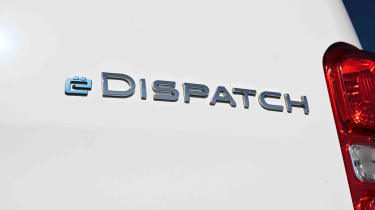
Electric range, battery life and charge time
The big change for the Citroen e-Dispatch during the 2024 revamp was the axing of the 50kWh battery model. You only get a 75kWh pack now, which means the e-Dispatch is competitive with rival electric vans in terms of battery capacity. Citroen quotes a range of 195-230 miles combined for the e-Dispatch, while the City range goes up to a maximum of 314 miles. Citroen quotes these range figures for all models in the line-up, but the heavier XL and Crew Van variants are less likely to achieve them.
As with other electric Stellantis models, the e-Dispatch performs best at lower speeds. Keep to urban routes or truck pace on the motorway, and you should be able to match the predicted range that’s delivered by the van’s trip computer. Go faster, and at 70mph you can expect to lose around two miles of range for every seven or eight miles travelled.
The e-Dispatch has a CCS charging socket that’s located on the nearside front wing behind the front wheelarch – the diesel model’s filler flap remains, but it’s locked shut. A maximum DC charging rate of 100kW is on offer, and Citroen says that a fast source will take the battery from five to 80 per cent capacity in 45 minutes. Much like any other EV, charging speeds slow significantly once beyond the 80 per cent mark. The e-Dispatch’s digital display shows the van’s charging status, and one intriguing piece of info displays the speed of the energy flowing from the charger into the battery in miles per hour.
Charging from a domestic supply will take the battery from flat to full in a day-and-a-half (37 hours), while a 7.4kW wallbox does the job in 11 hours 20 minutes. If you have access to three-phase 11kW charging, then an overnight charge will take seven-and-a-half hours. This is only available as a £400 option, though.
Load space and practicality
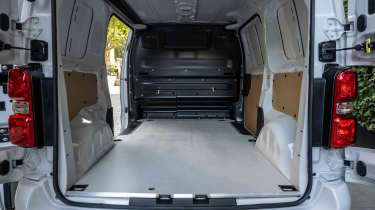
| Pros | Cons |
|
|
As with the smaller Citroen Berlingo, the Dispatch is based on a platform that sources its front section from the PSA Group’s EMP2 chassis. This means that Citroen has been able to add new safety tech without compromising cargo capacity, although a volume of 5.3 cubic metres for the Dispatch M is a little behind the class best in terms of outright space – a Ford Transit Custom offers 5.8 cubic metres of space, for example.
Moving up to the XL sees the van’s wheelbase remain the same at 3,275mm, but there’s an extra 350mm of rear overhang (up from 4,981mm to 5,331mm) and the van is slightly taller, too, (1,935mm, compared with 1,904mm for the M). This creates a 6.1 cubic metre space, but again, a Transit Custom offers a 6.8 cubic metre cargo volume.
The Moduwork bulkhead adds a removable steel panel that allows longer items to be carried; simply unlatch the panel, flip the passenger seat up, and there’s space for pipes, conduit or posts to be carried, possibly even a narrow ladder. This creates an extra 500 cubic centimetres of space, while the van’s load length at the floor increases from 2,512mm to 3,674mm. In the XL model, those measurements are 2,862mm and 4,024mm, respectively. It’s worth noting here that the shape of the van’s bulkhead and internal panels means that the length of the cargo area at mid height is 2,185mm, or 2,535mm for the Dispatch XL.
Other internal dimensions include 1,258mm between the wheelarches (which is only 29mm wider than the smaller Berlingo van), a 1,636mm maximum width and a height of 1,397mm under the roof, while the rear doors open to leave a space 1,282mm wide by 1,220mm high. The side doors measure 935mm wide and 1,241mm high, although that is on the small side for the medium-sized van class. At least you get a pair of sliding doors as standard, though.
Moving to the Crew Van, this features a six-seat layout and a proportional reduction in cargo space. Total cargo volume is 3.2 cubic metres for the M and four cubic metres for the XL, measurements that are roughly similar to the space offered in a standard Berlingo van. The Dispatch Crew Van has a plastic insulated bulkhead with a window, but there’s no through loading facility here. The cargo area measures 2,017mm long, or 2,365mm for the XL, with mid-height measurements of 1,352mm and 1,700mm, respectively. And of course access is only via the back doors, although you can add a top-hinged tailgate at extra cost.
Payload weights for the standard van are over a tonne for all models, including the electric versions. The best performer is the BlueHDi 145 manual in the M body, which has a maximum payload of 1,384kg. The poorest performer is the electric e-Dispatch XL Crew Van, at 915kg.
Braked towing weights are one tonne for all of the e-Dispatch variants, while the 1.5 BlueHDi can haul two tonnes and the 2.0 BlueHDi can manage 2.5 tonnes. It’s worth noting that while Citroen quotes a towing weight for the e-Dispatch, the only tow bar offered on the options list is exclusively for the diesel model.
Reliability, safety and security
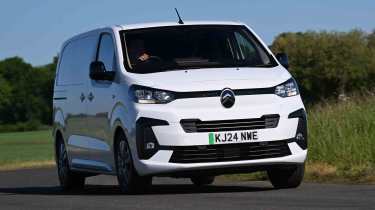
| Pros | Cons |
|
|
The Dispatch features lots of safety and assistance tech courtesy of the car-derived parts of its platform. All models now come with driver and passenger airbags, while the Crew Van adds side airbags, too. The full-height steel bulkhead featured in the van version will be strong enough to keep the cargo and passenger separate in the event of a collision, too, while the plastic item in the Crew Van is reinforced to boost its resistance to impacts.
All models come with lane-departure warning, driver-attention alert and speed-limit recognition technology, which is a significant upgrade on the earlier Dispatch and comes courtesy of new vehicle legislation that has made these systems mandatory on new models. The tech, along with autonomous emergency braking, helped the Dispatch earn a four-star rating in the Euro NCAP commercial vehicle tests, with a 75 per cent score for the safety kit on board, 52 per cent for the crash avoidance systems and 80 per cent for post-crash safety.
Tyre-pressure monitors are fitted as standard, but a full-size spare wheel can be added for £160. It also comes as part of the Worksite Pack that also adds a raised ride height and a sump guard for £950.
Citroen’s Visiopark 180 system is a recommended addition. It’s standard on Driver vans and an option on Enterprise, but it adds front and rear parking sensors, while the rear camera provides added peace of mind when reversing. The side-view camera, which is part of the Dynamic Surround View pack (£1,250), provides added visibility in the Dispatch’s nearside blind spot. This shows the feed from a camera mounted in the wing mirror alongside the standard camera’s rear view and is a big help when moving to the left.
With so many other vans sharing the same basic underpinnings, strength in numbers dictates that any issues there are should be ironed out, and with nearly a decade of production experience behind it, the Dispatch should be a safe and secure model for business users, whether you choose diesel or electric.
For security, there’s remote central locking with separate controls for the cab and cargo area, an engine immobiliser and auto door locks as soon as you accelerate over 7mph. An alarm is standard on the Driver model, but it’s a £225 option on the entry-level Enterprise version.
Driving and performance

| Pros | Cons |
|
|
The third-generation Dispatch set new standards for car-like comfort in the medium-sized van class. The driver benefits from a comfortable seat and a wide range of wheel and seat adjustment so it’s easy to get comfortable at the wheel, while the van’s tall driving position and short bonnet mean the view ahead is good.
One area we’d like to see improve is rearward visibility, because while some rival vans in the mid-size class have double mirrors with a wide-angle section beneath the main glass, the Dispatch makes do with a pair of standard mirrors. Citroen offers blind-spot detection and a side-view camera system, but adding wide-angle mirrors would surely be a cheaper alternative to do the same job? Whenever we’ve driven a Dispatch or any of its similar siblings, it’s always useful to do a right shoulder check when changing lanes, just in case something has crept into the blind spot.
The Dispatch’s diesel engines are a little noisy, but nothing untoward when compared with rival diesel vans. The 1.5 BlueHDi is fine at most speeds, although a heavy payload might mean extra effort is needed to keep going, which will blunt fuel economy.
The electric e-Dispatch is quiet and refined, while its 134bhp output means it delivers modest acceleration. It feels potent enough off the line, but once past the initial surge of acceleration, there’s not much more to give. The Eco, Normal and Power drive modes affect how much power is delivered, and you can see that on the vertical energy flow bar on the dashboard – in Normal mode, the bar doesn’t completely fill the space until you press beyond the step in the throttle travel.
In reality you’re going to be driving the e-Dispatch in Normal mode most of the time – it defaults to this setting on start-up, and the snappy throttle in Power mode can be tricky to judge, while the relative lack of power in Eco mode is likely to see you pressing the throttle harder to make progress, negating its effect.

Town driving, visibility and parking
There’s light steering and a relatively tight turning circle, while the Dispatch’s modest dimensions mean it’s nearly as easy as a small van to manoeuvre in town. Standard-fit rear parking sensors are a useful addition, though, to overcome the issue of the small door mirrors. The rear camera is useful when reversing, too.
The Dispatch with the manual gearbox is a bit harder to drive thanks to the slightly slack shift that it features – the auto and electric are far smoother in this regard. The eight-speed auto fitted to the diesel is a better unit to use than past transmissions, being far less jerky and more positive in its shifts.
While the last e-Dispatch had Drive and ‘B’ modes, with the latter boosting energy recuperation when slowing, the 2024 update introduced a three-stage system that’s controlled via paddles behind the steering wheel. It’s a far easier system to use, and the strongest setting is particularly good around town. Use it properly and you’ll hardly ever touch the brakes – although the brake lights do come on to warn other road users that the van is slowing quickly.
The system isn’t strong enough for one-pedal driving, but you soon get used to its character and the ability to slow without coming to a halt to make your driving smoother. It also helps to iron out the slightly jerky nature of the discs and pads, which can feel a little grabby at lower speeds.
Motorway driving and long-distance comfort
While there’s no powertrain noise, the e-Dispatch still suffers from wind and road noise at motorway speeds. It’s not outrageously loud, but noticeable. At least the ride is good, courtesy of the weight of that 75kWh battery set low in the chassis, under the cargo area, helping to iron out the ride.
You can achieve the same results with a heavy load in the back of the diesel, while road and wind noise are also present here, with a background hum from the diesel engines. When unladen, the Dispatch is a little bouncy, but the car-derived running gear boosts its refinement compared with rivals. One downside of this is a lower driving position than most rival vans, so it feels more like a car when you’re at the wheel.
We’d recommend setting the regenerative braking to its lowest level on faster roads, because lifting off the throttle when it’s on can cause the van to lurch uncomfortably.
Cab interior and technology
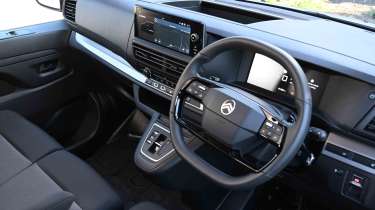
| Pros | Cons |
|
|
It’s designed with work in mind, and the hard plastics used in the Dispatch are as we’d come to expect in a van such as this. Items such as the rubber floor mats will be easy to clean, while the acres of black plastic should withstand hard knocks.
The dashboard layout is clear, and while the mid-life update added a larger touchscreen, the climate controls are still separate physical buttons and dials. There are rotary knobs for the temperature and fan speed, and large square buttons between them to control everything else.
Headroom is fine inside, but the cabin is quite narrow for a medium-sized van, so shoulder space is tight if you’re travelling three up – if you are going to be carrying two passengers regularly, then look elsewhere, or at least choose the auto or e-Dispatch, because then you won’t be awkwardly reaching in front of a middle-seat passenger to change gear. If you don’t need three seats, then you can switch to a two-seat configuration at no extra cost.
While headroom is good, there’s not enough room for any overhead storage, so you’re left with twin gloveboxes (although the lower one is just an open shelf), three door pockets on each side, twin cup holders at each end of the dashboard and a storage slot in the middle of the dash next to the twin USB-C sockets that’s good for holding a phone. The two passenger seats have storage beneath them (although there isn’t quite enough to get a charging cable under there in the e-Dispatch), while the middle seat back flips down to create a table.
The Crew Van has a 3+3 layout, so the back seats suffer from the same limited shoulder space as the fronts, although the sliding doors at least make access easy. Once in place the upright seating means longer trips might not be the most comfortable, while a lack of Isofix child seat mounts demonstrates that this is still a work machine rather than a family wagon – choose the Citroen SpaceTourer if that’s what you need. Unlike the smaller Berlingo Crew Van, the Dispatch does have glazing in its sliding doors, but the windows don’t open.

Infotainment, sat-nav and stereo
With higher-spec models being the only choice in the line-up now, all versions of the Dispatch feature a 10-inch high-definition touchscreen and a 10-inch driver’s display. The main screen is decent to use, with big buttons and simple controls, many of which are replicated on the multifunction steering wheel.
Sat-nav is standard with Driver trim and features six months of connected services, while a home button allows you to get back to the main screen with ease. There’s also another shortcut to the various driver assistance systems so you can set those up as you wish. Wireless smartphone connectivity is also offered, or you can plug into the USB-C sockets, and your phone’s mapping fills the screen nicely and to a good resolution.
The driver’s display is configurable to show different information via a button to the side of the screen. It can show trip data and energy flow between the powertrain and the road, while the display has a decent resolution for the size.
WiFi is included in the shape of Citroen’s Free2Move data plan. This allows businesses to issue schedules and other information to drivers out in the field, while also relaying a vehicle’s status, which can be useful if a service or roadside assistance is needed.
Alternatives
We’ve already mentioned half of the Citroen Dispatch’s rivals above, and with so much shared between the Citroen and its Peugeot Expert, Vauxhall Vivaro, Fiat Scudo and Toyota Proace siblings, it will be the smallest differences in price or spec that could make your decision. It’s worth noting that while the Stellantis models are all very similar, the Toyota Proace has slightly higher prices, plus the draw of the company’s warranty offer that adds 12 months of cover with every service for up to 10 years.
As we’ve said before, the Dispatch isn’t the biggest medium-sized van for cargo volume, and neither is the Volkswagen ID. Buzz Cargo, but the latter model does turn heads and has strong residuals, too. VW’s more mainstream offering is the Volkswagen Transporter, which has just arrived in seventh-generation guise. It’s more efficient than before and bigger than the Citroen, while the tech on board is more advanced. It’s the result of a partnership that has also brought us the UK’s best-selling van, the Ford Transit Custom. This model is our top choice in the class, and comes in diesel, electric and petrol plug-in hybrid guises (as will the Transporter in time), as well as a broad range of trim levels. As well as two body lengths and crew van options, the Transit Custom also comes with a high roof.
The Renault Trafic is another strong contender, as is the Nissan Primastar, which is a badge-engineered version of the Renault. Then there’s the Mercedes Vito, which has also been updated with more efficient diesels and a new all-electric option with a longer range than ever.
Van dimensions
| |||
| Body style | Height | Width | Length |
| Dispatch M (& Crew) | 1,904mm | 1,920mm | 4,981mm |
| Dispatch XL (& Crew) | 1,935mm | 1,920mm | 5,331mm |
Load area dimensions | ||||
| Body style | Height | Width | Length | Volume |
| Dispatch M (w/Moduwork) | 1,397mm | 1,636mm | 2,512mm (3,674mm) | 5.3m3 (5.8m3) |
| Dispatch XL (w/Moduwork) | 1,397mm | 1,636mm | 2,862mm (4,024mm) | 6.1m3 (6.6m3) |
| Dispatch Crew Van M | 1,397mm | 1,636mm | 2,017mm | 3.2m3 |
| Dispatch Crew Van XL | 1,397mm | 1,636mm | 2,365mm | 4.0m3 |
Frequently Asked Questions
It’s not our first choice in the medium-sized van sector because it doesn’t have the cargo capacity to match some of its rivals. Having said that, the twin sliding doors are an attractive standard feature and all models are well equipped, so if you can work with its smaller dimensions, you’ll be getting a van that’s quite car-like to drive and packed with features.

